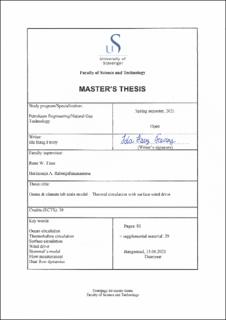| dc.description.abstract | Background: The earth receives more heat from the sun at the equator than at the poles. This imbalance is offset by the fact that heat is continuously transported from low-latitude oceans by large-scale winds and ocean currents towards high-latitude oceans. The return current is dependent on the density difference created by the temperature and salt difference in the oceans. This plays a key role in our climate, but we still don’t know much about how the system is affected by outside variables. The world is facing global warming issues, resulting in more ice melting and therefore a larger influx of freshwater to the high-latitude oceans, and stronger and more unstable wind patterns.
Purpose: The purpose of this thesis was to design, build and test a laboratory model for thermal circulation with surface wind. The model will be used by students, teachers and professors in the multiphase laboratory at the University of Stavanger. It was therefore also desired to have a detailed description of the components, equipment and techniques used.
Method: The thesis has an experimental design. Before building the model, a technical feasibility study was performed in order to find the best design. The feasibility study illuminates the down sides of the thermohaline circulation model currently situated in the multiphase laboratory, proposes different designs that satisfies requirements set by the faculty supervisors, together with measurement and conditioning systems.
Findings: Based on analysis of flow rate, it can be concluded that an air flow introduced in the same direction as a liquid surface moving due to thermal circulation would result in a positive impact on the flow rate. Air flow introduced in the opposite direction as a liquid surface moving due to thermal circulation would result in a negative impact on the flow rate. Experiments also proved that a higher wind speed introduced to a water surface allowed a higher amount of energy to be transferred from the wind to the liquid.
Conclusion: With the modifications done throughout the process, the final result was satisfactory relative to expectations. The experimental design functioned as intended, and the measurement data received during tests held a high quality due to the measurement equipment chosen.
Keywords: Ocean circulation, Thermal circulation, Surface circulation, Wind drive, Stommel’s model, Flow measurement, Temperature measurement, Heat flow dynamics, Pasco, Sensirion. | |
